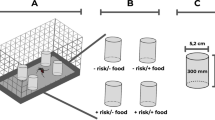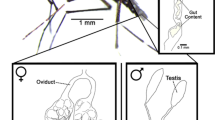Abstract
Behaviourial studies were conducted on the three main Anopheline Mosquitoes in Kapkuikui village, Baringo district, Kenya, namelyAnopheles gambiae s. 1.,A. funestus andA. pharoensis.
A. gambiae andA. funestus bite more often indoors than outdoors, with peak biting activity between 23–1 h and 1–3 h respectively. The two species were also markedly endophilic, the bulk of fed females resting indoors to complete egg development, even though some degree of exophily was observed among gravid femaleA. gambiae s. 1.
A. pharoensis on the other hand bites more often outdoors than indoors, attaining its peak biting activity before midnight. It was strongly exophilic in its resting habits.
The implications of these observations with respect to planning an effective mosquito control programme in the area are discussed.
Zusammenfassung
Es wurden Verhaltensuntersuchungen bei den 3Anopheles-ArtenA. gambiae s. 1.,A. funestus undA. pharoensis in der Stadt Kapkuikui, Baringo-Distrikt, Kenya durchgeführt.A. gambiae undA. funestus stachen mehr außer als im Hause mit Maxima der Stechaktivität zwischen 23 und 1 Uhr sowie 1 und 3 Uhr. Hinsichtlich der Ruheorte waren die beiden Arten deutlich endophil: die Hauptmenge der Weibchen hielt sich im Hause auf, um dort die Eier zur Entwicklung zu bringen. Nur unter den graviden Weibchen vonA. gambiae war eine gewisse Exophilie zu beobachten. Andererseits stachA. pharoensis öfter außer Hause und mit einem Stechmaximum vor Mitternacht. Auch ihre Ruheorte lagen stets außer Hause. Es werden an Hand dieser Ergebnisse die Möglichkeiten einer wirksamen Stechmücken-Bekämpfung in diesem Gebiet erörtert.
Similar content being viewed by others
References
Aniedu, I., 1988: Ecology of Malaria Vectors in relation to an irrigation scheme in Baringo district, kenya. Unpubl. Ph. D. Thesis, Rivers State Univ. of Science and Techn., Port Harcourt.
Aniedu, I.;Mutinga, M. J.;Mutero, C. M., 1989: Age composition and survival rate ofAnopheles gambiae Giles complex (Dipt., Culicidae) in Baringo district, Kenya. J. Appl. Ent.107, 387–394.
Dunkeen, M. H. Y.;Omer, S. M., 1986: Ecology of the Malaria Vector,Anopheles arabiensis Patton (Diptera; Culicidae) by the Nile in Northern Sudan. Bull. ent. Res.76, 451–467.
Gillies, M. T., 1954: Studies in house leaving and outside resting ofAnopheles gambiae Giles andAnopheles funestus Giles in East Africa. 1. The outside resting population. Bull. ent. Res.45, 361–373.
Gillies, M. T., 1967: Age group and biting cycle inAnopheles gambiae. A preliminary investigation. Bull. ent. Res.48, 553–559.
Gillies, M. T.; De Meillon, B., 1968: The Anopheline of Africa South of the Sahara (Ethiopian Zoogeographical region). Publ. of the South Afr. Inst. for Med. Res. 54, 342 pp.
Haddow, A. J., 1942: The mosquito faina and climate of native huts at Kisumu, Kenya. Bull. ent. Res.33, 91–140.
Hanney, P. W., 1960: The mosquitoes of Zaria province, northern Nigeria. Bull. ent. Res.51, 145–171.
Holstein, M. H., 1954: Biology of Anopheles gambiae Research in French West Africa. Wld. Hlth. Org. Monogr. Ser. 9, 173 pp.
Iyengar, R., 1962: The binomics of saltwaterAnopheles gambiae in East Africa. Bull. World Health Organ.27, 223–229.
Krafsur, E. S., 1977: The binomics and relative prevalence ofAnopheles species with respect to the transmission of plamodium to man in Western Ethiopia. J. Med. Entomol.14, 180–194.
Muirhead-Thomson, R. C., 1948: Studies onAnopheles gambiae andA. melas in and around Lagos. Bull. ent. Res.38, 527–558.
Muirhead-Thomson, R. C., 1982: Behaviour patterns of blood-sucking flies. Pergamon Press, Oxford, 224 pp.
Mutero, C. M.;Mosha, F. W.;Subra, R., 1984: Biting activity and resting behaviour ofAnopheles merus Donitz (Diptera: Culicidae) on the Kenya coast. Ann. trop. Med. Parasit.78, 34–47.
Smith, A., 1958: Outdoor cattle-feeding and resting ofAnopheles gambiae Giles andAnopheles pharoensis Theobald in Para-Taveta area of East Africa. E. Afr. Med. J.35, 559–567.
Smith, A., 1962: Malaria in the Taveta area of Kenya and Tanganyika. Part III. Entomological findings three years after the spraying period. E. Afr. Med. J.39, 553–564.
Subra, R., 1980: Biology and Control ofCulex quinque fasciatus Say, 1823 (Diptera: Culicidae) with special reference to Africa. Unpubl. WHO document. WHO/UBC/80, 781.
Van Someren, E. C. C.;Heish, R. G.;Furlong, M., 1958: Observations of some mosquitoes of Kenya Coast. Bull. ent. Res.49, 643–660.
White, G. B., 1974:Anopheles gambiae complex and disease transmission in Africa. Trans. R. Soc. trop. Med. Hyg.68, 278–298.
World Health Organisation, 1972: Vector biology. Report of a WHO Scientific group. Techn. Rep. Ser.501, 38 pp.
World Health Organisation, 1975: Manual on Practical entomology in Malaria. Part II: Methods and Techniques. WHO offset Publ.13, 191 pp.
Author information
Authors and Affiliations
Additional information
With one figure and 2 tables
Rights and permissions
About this article
Cite this article
Aniedu, I. Biting activity and resting habits of malaria vectors in baringo district, kenya. Anz. Schadlingskde., Pflanzenschutz, Umweltschutz 66, 72–76 (1993). https://doi.org/10.1007/BF01903074
Issue Date:
DOI: https://doi.org/10.1007/BF01903074




